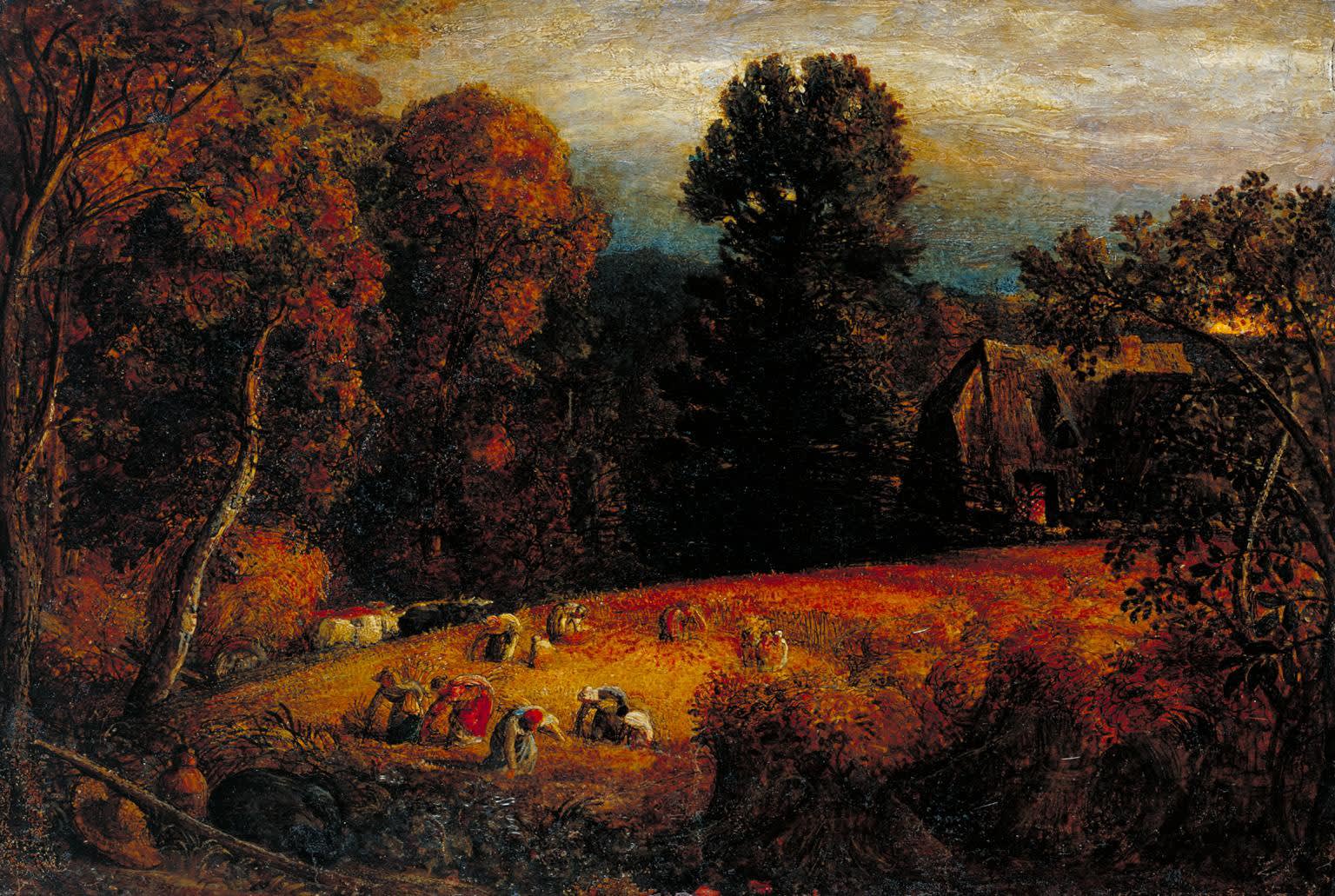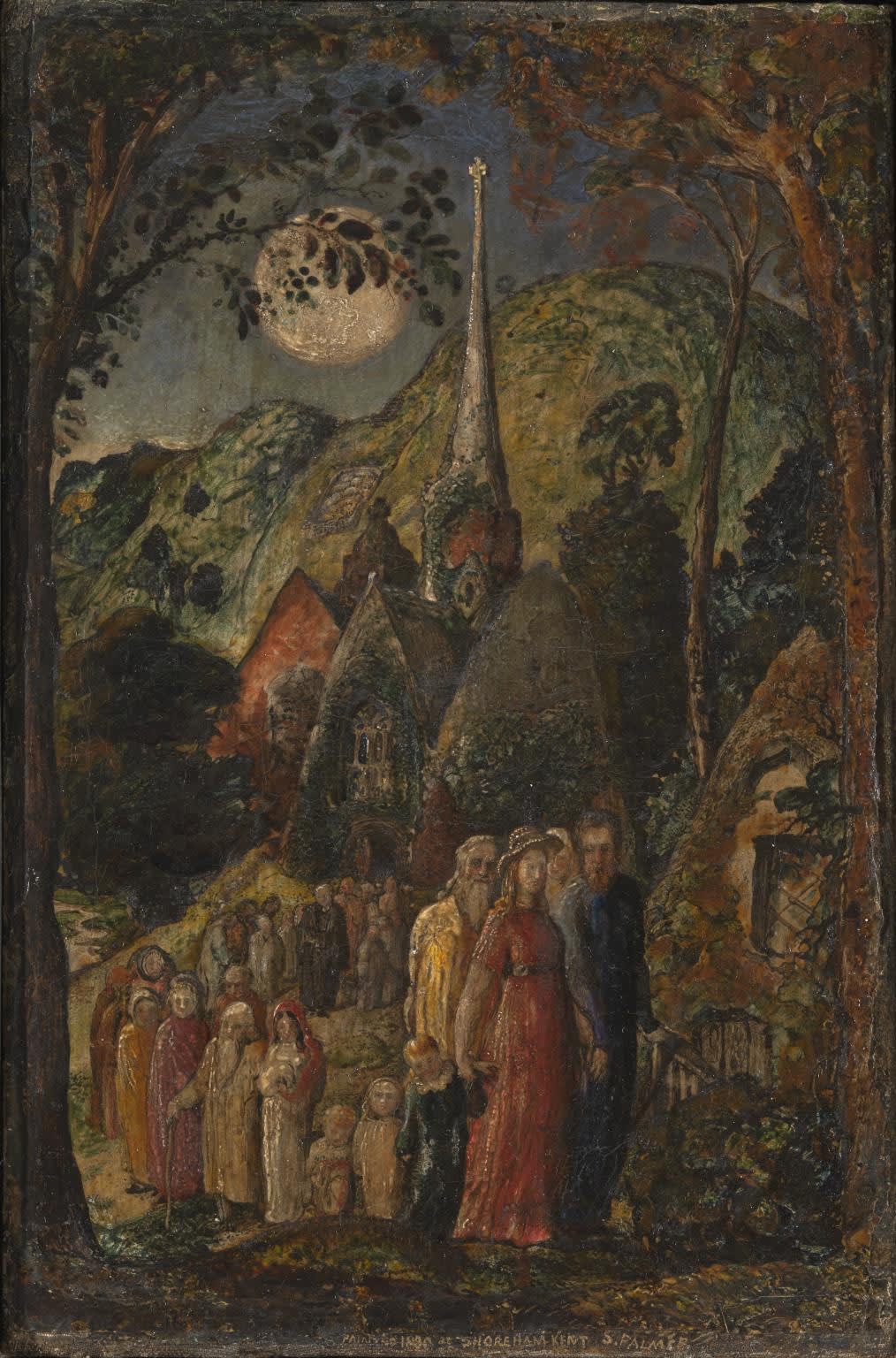
Samuel Palmer, The Gleaning Field c.1833. Tate Britain
Small Matters
I have always loved looking at small things. As a child, I was fascinated by the scales of a fish, frozen inside the surface ice of a lake; or the skin of a small lizard in summer, with its thousands of shiny and stripy diamonds. I liked the way the light picked them out, wrapped them, embalmed them in what seemed like another surface.
When a little older, and in London, I liked the same things about small painted miniatures of warriors and monsters; the light was painted on, in addition to the real light falling on their textured surfaces. A double light, one owned and controlled by the artist, the other in the lap of the gods.
But scale seemed to be important in either case. Make it too big, and the light is lost, stretched out, like the difference between the vastness of the ocean and glittering dew drops on grass.
Most of my favourite paintings in London are small. Or relatively small to their visual density. They are made by ‘true’ miniaturists, which I think I mean that their small physical scale is incommensurate to the largeness of the visual world that they suggest. The first mention must go to the two Pisanellos in the National Gallery. The Vision of Saint Eustace is both mystical and dark, as well as descriptive and taxonomical. The bosky shade is decorated by animals, and looks like a tapestry, or a bestiary. They swim in the murky greens of the wood, and St Eustace floats in it like a ship. It is like Celtic myth combined with the Renaissance noon. The Saint George in The Virgin and Child with Saints (1435 – 41) is a favourite character of mine: the shepherd warrior. His armour plates bend and join like plough shares, and his incongruous, massive, pleated straw hat is one of a kind. The gold parts are made with gold paste, and the sword hilt is high relief. It catches the light but does not intrude, in a way only a small painting can.
Another undisputed master of the small epic is Watteau; the concentration of his works at the Wallace Collection is unsurpassed. The glazes, mottling, cascading impasto, washes and lines, the controlled and gentle chaos, pick up the light as well as emanate it from within. There is a very subtle sense of dryness, or matt-ness, a fuzzy brushiness on the old stones, the green sward, skin and sky – to contrast with the slithering silk dresses.
Which leads me to works that are all shine, liquid depths, and clumsily thick glaze: the two small pictures by Samuel Palmer hanging in Tate Britain. The Gleaning Field (1833) and Coming from Evening Church (1830). I love Palmer, like I love Clare, they go together, their romance is real, the country idyll revealed in youth (“more than Eden”) then snatched away by the cares and carelessness of the world. One cannot escape the cliché ‘jewel-like’ with these disturbing, elfin pictures; and it is because their thick glaze and underlying pigments act like the reflective foil and paste glass of 19th century bijouterie. But of course, it is the artlessness of the materials, heaped into blobs and undulations (but never too much, never so that it is conceit), that makes is so precious.
In this time of stoppage and anxiety (like running gloopily in a nightmare), which itself has become a kind of formal cliché (“stay safe”, “in these difficult times”), I began to think not that small works are equal to large ones, that we know already: but that the small may be greater than the large. If every virtue, for instance, requires a struggle and an overcoming (‘courage’ without overcoming ‘fear’ is just foolishness), then does not the physically small overcome its limitations and becomes a world? It is less needy, less needful of our care, our purses, space, its claim to existence is more modest yet unfurls ever more magnificently. And we can enjoy looking at small works on our computer screen or in a book in a more direct way, in almost a physical way, appreciating the raised or depressed areas, the marks and brushwork. It is like the light of our own lives stroking the painted light in the image.
Miroslav Pomichal, April 2020

Pisanello, 'The Vision of Saint Eustace', (c1438-42), National Gallery, London

Pisanello, 'The Virgin Child with Saints', (c1435-41), National Gallery, London

Antoine Watteau, 'Sous un Habit de Mezetin', c.1717-19, Wallace Collection

Samuel Palmer, 'Coming from Evening Church', 1830, Tate Britain




